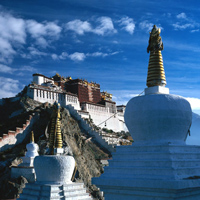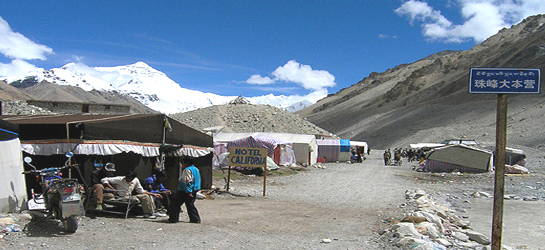Lhasa
Lhasa Overview
-
Adventure tour
Lhasa, in the southeast part of Tibet, surrounded by colossal mountain ranges to the north and south, is the heart and soul of Tibet, its center of politics, economy, religion and culture. Not only the world famous symbol of the enigmatic power of politics and religion, the Potala Palace, is a great and breath-taking site of this city. Also for example the Jokhang Temple is an UNESCO site, the spiritual center and the holiest shrine of Tibet.
Highlights:- The most famous historic sites and great creations of Tibetan Buddhism: The Potala Palace, the Jokhang Temple, Norbulingka, Sera monastery, Drepung Monastery & Ganden Monastery.
Best time to Visit
-
The best time to visit Tibet is from April to October, avoiding the coldest months during the year. However, most rainfall also comes during this season between June and September.
How to get there?
-
Beijing to Lhasa about 4064KM
Shanghai to Lhasa about 4373KMPlane and Train information (return)
Plane:
Beijing to Lhasa
CZ3183 (07:50-13:30) or CA4112 (08:55-14:40)
Lhasa to Beijing
CZ3184 (14:40-20:30) or CA4111 (15:55-21:30)Shanghai Pudong to Lhasa
MU2335(08:10-15:20)
Lhasa to Shanghai Pudong
MU2336(16:10-22:40)
Full Price Air Ticket (one way)
Beijing-Lhasa: RMB2630
Shanghai-Lhasa: RMB2960Train:
Beijing to Lhasa T27(21:30-20:20) 46.5 hours
Lhasa to Beijing T28(08:30-07:34) 47 hours.Shanghai to Lhasa T164 (20:08-21:00) 48 hours and 52 minutes
Lhasa to Shanghai T166 (10:00-10:58) 48 hours and 52 minutesTrain tickets are very difficult to purchase. Tickets are released for sale very close to the departure date and are very popular.
Traveling time between major cities and road conditions
Lhasa—Tsetang 200KM City roads 3 hours
Tsetang—Gyantse 330KM City roads 4.5 hours
Gyantse—Shigatse 90KM City roads 1.5 hours
Shigatse—Lhasa 260KM City roads 4 hours
What to see
-
Built on Lhasa’s highest point, the Potala Palace is the greatest monumental structure in Tibet. It is thirteen stores high, has over a thousand rooms and was once the residence of Tibet’s chief monk and leader, the Dalao Lama. Like this it was the center for spiritual and temporal power. It has two main sectionsm the White Palace built in 1645 and the Red Palace, completed in 1693.
The Palace had multiple functions: the residence of the Dalai Lama and his large staff, the place all ceremonies of state were held, the seat of Tibetan government and it also housed a school for religious training of monks and administrators. In addition, it was one of Tibet's major pilgrimage destinations because of the tombs of past Dalai Lamas.
The Potala's most venerated statue, the Arya Lokeshvara, is housed inside the Phapka Lhakhang, and it draws thousands of Tibetan pilgrims each day.Lukhang, a temple dedicated to the king of the water spirits, is located on an island in the lake behind the Potala. With great attention to details, the upper floors are decorated with striking murals, once offering visual guidance to the Dalai Lamas who retired here for periods of spiritual retreat.
The three story Ramoche was built in the 7th century by Songtsen Gampo to house the statue of Tibet’s most venerated Buddha image, Jowo Sakyamuni.
The Jokhang Temple was founded in AD 639 to house an image of the Buddha which was brought as dowry by the Nepali Princess Bhrikuti on her marriage to King Songtsen Gampo. The prostrating pilgrims, flickering butter lamps and wreaths of heady incense create an unique atmosphere.
Norbulingka means Treasure Park in Tibetan, and it is the former Summer Palace of the Dalai Lamas. In the past, it was for Dalai Lamas and high officials only, but now it’s a park opened to both locals and visitors, where you can enjoy a beautiful view of Lhasa.
Barkhor, Lhasa’s liveliest neighborhood, fascinates visitors with its bustling atmosphere when especially by dusk crowds of pilgrims and locals are at the streets.
Sera Monastery
Sera Monastery stands at the foot of Sera Utse Mountain in the northern suburb of Lhasa, is famous for its monks' debates. There are two traditions as to why the monastery was named Sera. One is that a fierce hailstorm occurred when the monastery was founded; the other is that a large tract of wild roses bloomed where the monastery now stands. Since both the words 'hail' and 'wild roses' are 'sera' in Tibetan, the monastery was named Sera.
A debate begins at 3 P.M. every day. Hundreds of monks gather in the garden to practice and debate Buddhism with others.
Useful Information
-
Altitude awareness
The altitude of Lhasa is 3650 meters, and the air pressure there is quite low. So oxygen cylinders and medicine for diarrhea, headache and Mountain Sickness are recommended.
What to bring?
Prepare sunglasses, a good sun block, and a hat to protect you from the sun's harmful rays.
More Information
-
Staying Healthy
You will be easily exhausted there, so try not to walk too fast or even run when you first arrive there. And also do not eat too much, or drink alcohol. Eat more vegetable or fruit, and pay attention to keeping warm.
Food
The food in Lhasa is mainly Tibetan style and Sichuan style. Some of the restaurants can provide Nepal and Indian dishes.
Shopping
Tibetan Costumes: Less affected by other costume cultures, Tibetan costumes remain in their original style. Both the style and the color combinations are very exotic. A piece of clothing, a small hat or even a piece of pulu will win the admiration of friends who have not been to Tibet.
Masks: Masks are used in religious ceremonies, in Tibetan operas and masks of Buddhist gods are hung over the girders of monasteries.
Tibetan Knives: Besides their practical functions, Tibetan knives can also be used as a kind of accessory. Carved with various pictures on the sheath and adorned with shining jewels, they may outshine any item in your collection.
Also famous: Tibetan carpets, Tibetan paper, wooden bowls, embroideries and bone carvings, etc.
Festivals
Tibetan New Year is the most significant festival in Tibet. Different areas have different ways to celebrate it, with Lhasa the most representative.
Butter Lantern Festival
The Butter Lantern Festival is also called Lantern Festival, which happens on January 15 of Tibetan calendar. It is also the last high tide of celebrations of the Tibetan New Year. On this day, people go to temples to burn incense to worship Buddha. At night, they will display the butter lanterns they make themselves. These lit lanterns make the streets appear as if it was daylight. THe Tibetans celebrate the night by sinig and dancing..
Ongkor Festival (Bumper Harvest Festival)
The Ongkor Festival is an old festival in farming areas of Tibet held in each August according to Tibetan calendar when all crops are harvested.
Major activities include horse racing, shooting, singing and dancing, Tibetan Opera, stone holding and wrestling.
Horse Racing Fair and Archery Festival
Horse Racing Fair is a unique festival held in a grazing area of Tibet. It is usually held between June and July in Tibetan calendar, when the pasture is lush and horses and cows are stout and strong. The horse racing is seen every year, but a large one is held every two or three years. It will last several days, with the longest ones over ten days. The most famous ones of them are the Kyagqen Horse Racing Art Festival of Nagqu and Darma Festival of Gyangze.
Sagar Dawa Festival
Sagar Dawa is an influential religious festival in Tibet, representing April in Tibetan calendar. Buddhism believes that Sakyamuni was born, became Buddha and died in April, so the Sagar Dawa Festival mainly focuses on worshipping Buddha in the inner, middle and outer parts of Lhasa. The festival reaches its climax on April 15, which is considered the birthday and the day that Sakyamuni entered nirvana.


 7 Days Tibet (Lhasa, Tsetang, Shigatse)
7 Days Tibet (Lhasa, Tsetang, Shigatse) 5-Day Essential Tibet
5-Day Essential Tibet Overland Through Tibet To Mount Everest
Overland Through Tibet To Mount Everest



